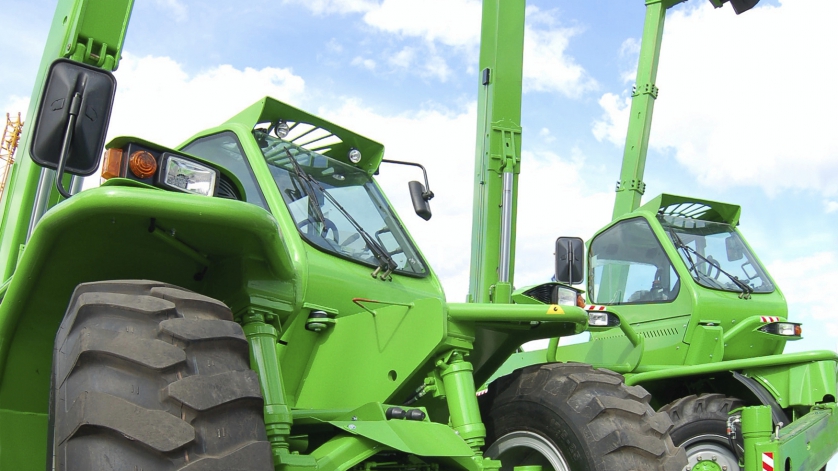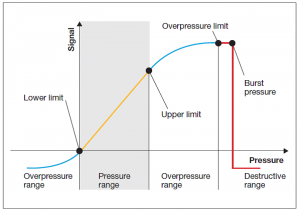
Despite the fact that pressure sensors are available in many different pressure ranges today, most pressure sensors failures in the field can be traced to overpressure. Data shows that over 50% of pressure sensors that fail in the field have been subjected to pressure well above the safe operating limit – resulting in shifted and drifting zero signals, destroyed sensor elements or even burst diaphragms. To prevent pressures sensor failure from pressure spikes and overload, the instrumentation engineer has to choose between:
- Selecting a pressures sensor with a sufficiently high pressure range to make sure it never, ever gets overloaded, and;
- Selecting a pressure range small enough to give sufficiently high signal levels and accuracy.
Selecting a Pressure Sensor Measuring Range
Besides selecting the brand, model and accuracy (a detailed discussion of which can be found in: Introduction to Pressure Measurement and Interpreting Accuracy and Error), the selection of an appropriate measuring range of a pressure sensor is one of the most important steps in the purchasing process. First and foremost it is important to understand that any pressure sensor faces permanent damage if the pressure rises above the “safe operating pressure.” Even slight or very short exposure to a pressure above this level can lead to permanent and irreversible damage, typically seen as a “shifted” zero signal. Furthermore, this is true even if the pressure sensor is not on, as the sensor is still susceptible to overload. When selecting the pressure range of a particular sensor the typical question is: What is the maximum operating pressure in the system? If the answer is 2650 psi, a typical choice would be a 3000 psi sensor. That sensor may easily have a safe overpressure rating of 2-3 times, e.g. 6000 – 9000 psi. Sound safe? Absolutely. Can this sensor fail due to overload? Absolutely! A number of situations in fluid power systems can damage pressure sensors. For example:
- “Water Hammer”, i.e. highly dynamic pressures spikes caused by fast closing valves when fluid is flowing;
- Cavitation, either caused by pumps or sudden pressure drops;
- Micro Diesel effect, i.e. explosion of tiny bubbles in the fluid with a sudden rise in pressure;
- Mechanical impact from outside on hydraulic cylinders, e.g. an excavator bucket hitting a rock in full movement, or swing, or a fork lift dropping the fork and hitting the floor;
- Certain service conditions, e.g. overpressure testing of systems during manufacturing or installation;
- Extreme conditions during transit;
- Extreme conditions when the system is shut off, e.g. pressure rising in a refrigeration system when shut-off and temperature rises on the roof top in the full sun with no cooling;
- Inadvertently swapping the low pressure sensor (600psi) to the high pressure (6000psi) side of a hydraulic system during installation or service.
Keeping the above in mind, deciding on the right pressure range for a sensor is a classical engineering dilemma: the rated pressure range needs to be large enough to make sure the sensor is not damaged but also small enough to get a sufficiently high signal and avoid compromises in resolution and accuracy. The first and most important step in making a decision is to understand how the pressure range of a sensor is defined and how this is applied to a particular situation.
Pressure Range Values
When looking at the data sheets of different manufacturers, you will typically find three different values regarding the pressure range:
- Rated pressure range (or operating/nominal pressure range)
- Over pressure range (or safe operating pressure range, maximum safe pressure range)
- Burst pressure (or maximum permissible pressure)
The graph below shows how these three important values relate to each other:  The most important facts to understand are: Within the rated pressure range, the sensor can typically be used for a virtually unlimited or at least a very large number of load cycles (typically >10 million and often > 100 million) without any degradation and with no effect on the specified accuracy or durability. Once you leave the rated pressure range, the effects for a specific application need to be carefully evaluated in regard to the exact definition of each manufacturer for a particular model. On the other hand, if you choose a pressure range that is too large for safety, accuracy and resolution may be impacted. If your application requires accurate measurements of only a fraction of the rated pressure range of the device, you need to carefully evaluate your needs and the best device for the job.
The most important facts to understand are: Within the rated pressure range, the sensor can typically be used for a virtually unlimited or at least a very large number of load cycles (typically >10 million and often > 100 million) without any degradation and with no effect on the specified accuracy or durability. Once you leave the rated pressure range, the effects for a specific application need to be carefully evaluated in regard to the exact definition of each manufacturer for a particular model. On the other hand, if you choose a pressure range that is too large for safety, accuracy and resolution may be impacted. If your application requires accurate measurements of only a fraction of the rated pressure range of the device, you need to carefully evaluate your needs and the best device for the job.
WIKA is here to help you with all of your instrumentation needs. Please contact us if you want to learn more about selecting the right pressure range for your pressure transmitters or if you have any questions about our products.

